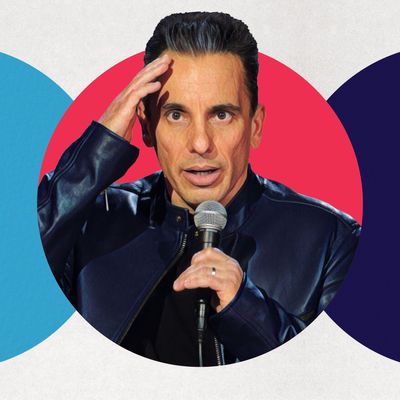
This past weekend, just a few days after the release of his fourth hour special, Stay Hungry, on Netflix, Sebastian Maniscalco played Madison Square Garden. Now of course, Maniscalco is not the first stand-up to play the World’s Most Famous Arena over the past decade, but he undoubtedly got there differently. Maniscalco, without a breakout TV or film role, built a tremendous fan base the old-fashioned way: one joke at a time, one audience at the time.
One of those jokes, “Doorbell,” is the subject of this week’s episode of Good One, Vulture Comedy’s podcast about jokes and the people who tell them. Easily one of the most well-known jokes of the 21st century, after appearing on Maniscalco’s 2012 special, What’s Wrong With People?, and later clipped on Facebook, it was the joke that put him on the map, the joke that kicked everything into high gear.
Listen to the episode and read a short excerpt of the discussion below. Tune in to Good One every Monday on Apple Podcasts, Spotify, or wherever you get your podcasts.
In an interview a few years back, you were talking about your material, and you said something like, “Look, it’s not groundbreaking stuff.” You’re being humble, but I think what you were trying to say is that ultimately it’s simple, everyday premises that allow you to really play on top. What do you like about simple, relatable subject areas?
Yeah, I’m not about clever. I think you’re right. I said that it’s not groundbreaking, and that’s a great way of explaining that statement. Simple everyday stuff. You don’t got to look too far for material. It’s always right in front of you. I’m just reporting the news, really.
It works for me because it resonates with everybody. You don’t have to be specific. Like some people talk about smokin’ pot, right? Now, if you don’t smoke pot, you might not get the joke because you don’t know what it’s like to be on pot. I like to do jokes that everybody could relate to regardless if you’re smoking pot, drinking beer, what have you. Everybody is living their day-to-day life, and the observations that I might make at Starbucks or Chipotle I believe that a lot of people have been through and can relate to it.
Where did the doorbell joke start? And how did it develop?
It started at my kitchen table in Chicago when I was around 23. The doorbell had just rang — it was a family member — and my family talked about the doorbell, how it is today and how it was 20 years ago: “Remember, you used to go sliding up to the door, and now a murderer could be on the other side.” When I started to do stand-up, I think my sister reminded me, “Remember that time we were talking about the doorbell?” I took what we were talking about at the table to the stage. The second prong is the act-outs. I paint a picture of what’s going on. I tell people to get down. I get on one knee. People really enjoy the physicality.
Why do you think people respond to your pantomimes as strongly as they do?
I have a seriousness about me. You don’t think that I’m going to be physical or expressive onstage. When a guy like me acts goofy, it’s unexpected.
When you’re deciding on specifics in your act-outs, like how you open a door, is it trial and error or more in the moment?
More trial and error. In telling the story, you find those moments where physicality is needed, then you embellish it. At Second City, I learned to make my pantomimes very specific. If you’re going to open up a door or a window, you want to make sure so that people can see the door or the window open and close. You make it the same movement every night because it becomes consistent and you know the type of laughter you’re gonna get. The range of movement is all determined in the practicing of the bit.
There are two types of act-outs in this joke. There’s one where you are inhabiting a character, like the mother or the father, while you’re still telling the story. In your mind, are you picturing actual people and places?
When I’m doing the doorbell bit, I’m taking myself back to the house I grew up in. I know what the door looks like. I know what the little peephole looks like. When I’m serving the cake, I envision my family at a table, me putting down an Entenmann’s cake and saying, “You want a cup of coffee?”
In the way you open the door or how the kids jump out of the couch, it’s more of a discreet act-out. You’re not doing a full persona, you’ll do a burst.
Yeah, it’s a very pronounced movement. I liken it to Michael Jackson’s kick, where he just popped up, gave a kick, and it’s like, Whoa. It’s very explosive, but then there are smaller movements, too — like my father going, “Let’s get out of here,” and just moving your fingers slightly. You know he means business. Whispering or mouthing something to the audience, you can almost feel them come to you.
You said in an interview that sometimes your comedy is less about a joke and more about a face you make when reacting to something. If you’re inviting the audience to view the world through your eyes, what is it about you that is funny to these people?
I see the world through a disdain of human behavior. I also see the world in a family sense. When I do my act, there are a lot of differences. My wife comes from wealth; I come from the middle class. There are a lot of differences there. Also, I find what works is nostalgia: This is how it used to be; this is how it is now. In the new special, I do a bit about how fighting was different in the ’80s than it is today, because of mixed martial arts. Back in the ’80s you had a black eye. Now you could be in a wheelchair eating through a straw if you fight the wrong guy. Nostalgia covers a broad audience, too. That doorbell bit, an 80-year-old grandmother could relate to as well as an 8-year-old granddaughter.
You’re playing Madison Square Garden this weekend, and this piece will come out once your show is over. It feels like you’ve reached some sort of summit. How do you feel about it?
I don’t know where you go after you’re on the top of the mountain. You fall off? You play the Vatican? I don’t know. It’s not like I’m looking to top this. To me, it’s more about my act. Don’t get me wrong, I’m flattered that 80,000 people are coming to see comedy this weekend. I mean, that’s crazy, but it’s a little overwhelming.
Your first few years starting out, you worked as a waiter. When you do a show, how do you try to provide good customer service?
I like people to come to the show and be transported into my world. So first and foremost, I have to be on my game. I have to deliver comedy for an hour and 20 minutes. That’s what people pay to see. For the show at the Madison Square Garden, there’s more excitement in the air. There’s pyro involved and LED screens in the proscenium so people can see the act-outs. It’s making it more of a show than just walking out onto the stage and going, “What’s up guys?”
When I was doing clubs, I would stay until everybody left. I would take photos, sign DVDs, talk to people. I felt like, Hey, if you’re going to spend the night with me, I want to thank you for paying for parking, the tickets, the two-drink minimum. I obviously can’t do it now, just because of the size of the audience. I’d be there for three weeks. But if you’re coming to a show, you’re stepping into my house, and my version of coffee and cake is the comedy.


